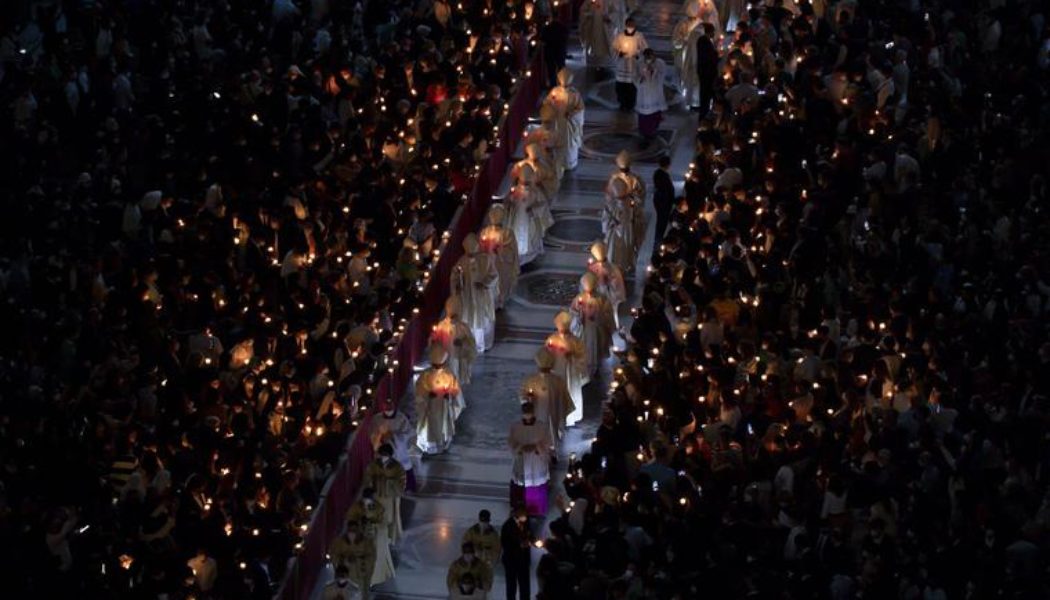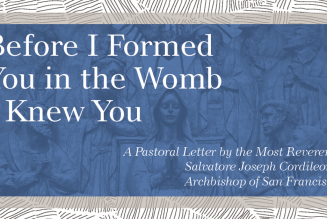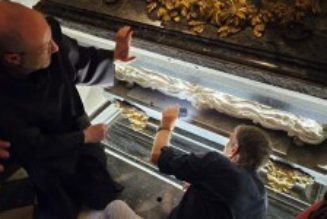
The lack of artificial lighting during the Easter vigil can be a powerful aid to prayer, raising the question of why this practice isn’t done more regularly.
If you attended the Easter vigil this past weekend, you experienced one of the Catholic liturgy’s most unique (and arguably spiritually compelling) aesthetic sequences: a pitch-black church, increasingly illuminated by the light from the Paschal candle.
But you also might have been left with a question: Why aren’t more liturgies celebrated with the artificial lighting off — or at least far more dimmed than seems to be typical?
While there are obvious reasons that the Easter vigil, the liturgy commemorating Christ’s resurrection from the dead and the culmination of God’s salvific action throughout the ages, is celebrated with the lights off until the Gloria and the transition into the New Testament readings (or, at least until the sequence of readings begins), it’s not necessarily clear why more ordinary liturgies couldn’t also rely less on artificial lighting — especially if, as many seem to suggest, the experience of lights-off liturgies like the Easter vigil is so spiritually impactful and conducive to contemplative participation in the Mass.
For instance, daytime Sunday Masses at most parishes seem to be typically celebrated with the lights cranked up to 11 — despite the availability of natural lighting. Sunday is indeed the day of fiat lux — but need it be the day of “fiat lux artificialis”?
According to Jesuit Father Tony Lusvardi, “there’s something to be said for natural light.” Referencing Joseph Ratzinger’s The Spirit of the Liturgy, Father Lusvardi said that the significance of the sun as a cosmic symbol of Christ meant that worship has traditionally been directed toward the east and the rising sun — a theological decision with aesthetic effects.
“Before electricity, the effect of natural light was part of the design of churches and the liturgy itself,” said Father Lusvardi, who teaches sacramental theology at the Pontifical Gregorian University in Rome.
You can see the impact of this kind of design, Father Lusvardi says, in a place like St. Peter’s Basilica in Rome, where massive windows let in streams of light — “so much light, in fact, that at the right time of day, the dome seems to be floating — held up by the light.”
Of course, the Catholic liturgy does incorporate non-solar sources of light: candles, the use of which is obligatory.
But Father Lusvardi notes that the “felt impact of candles is probably diminished by bright electrical lighting.”
“Candles probably become a better symbol of hope — think of the Advent wreath — when they provide light in the darkness,” he said, adding that the impact of pre-artificially-lit vigils was probably enhanced by worshipping by candlelight and gathering around “the light in the darkness.”
Lights-off liturgies do exist outside of the Easter vigil, notes liturgical scholar Christopher Carstens, who cited the extraordinary form celebration of the Rorate Masses and the monastic practices of matins. At times in the Church’s history, Father Lusvardi adds, darkness had been thought to be conducive to prayer, and church windows were even covered up to this effect.
On the flip side, others have pointed out that in some parts of the world where artificial lighting may not be as widespread or at least not as thoroughly taken for granted as it is in the West, gaudy artificial lighting is used as something of a substitute for gold or other precious materials, a sort of “neon baroque” style that incorporates a valuable commodity into worship and the church aesthetic.
In terms of what the Church’s governance actually says regarding lighting and the liturgy, Father Tom Margevičius says there’s no explicit requirement for what level the overhead lighting needs to be set at during the liturgy. Instead, the director of worship in the Archdiocese of St. Paul and Minneapolis points to the General Instruction of the Roman Missal, highlighting a passage that instructs places of worship to be “arranged with appropriate care” so that [the faithful] are able to sensibly participate in the sacred celebrations, “duly following them with their eyes and their attention.”
He also refers to Built of Living Stones, the USCCB’s 2001 guidance on church aesthetics, which he says emphasizes the important of having well-lit spaces for theological reasons —“Jesus is not the Dark of the World” — as well as safety.
“Someone falling off a dimly-lit sanctuary step would hardly say her worship was thereby enhanced,” quipped the diocesan priest.
“That said, there is no reason harsh, blinding light (especially artificial) is preferable to tactful use of natural light,” Father Margevičius told the Register, noting the positive impact liturgical architects and “a knowledgeable liturgy/environment committee” can have on their parish.
Father Lusvardi doesn’t think that artificial lighting should be done away with, but that it could be used more effectively to contribute to the liturgy. He suggests, for instance, that lighting settings could better reflect the liturgical season, though he cautions against using lighting in a way that becomes “theatrical.”
“No spotlight following the celebrant.”
And while it might not be feasible or even desirable to revitalize the celebration of the liturgy exclusively by candlelight, with the lights turned off — can we at least turn them down?
Join Our Telegram Group : Salvation & Prosperity







